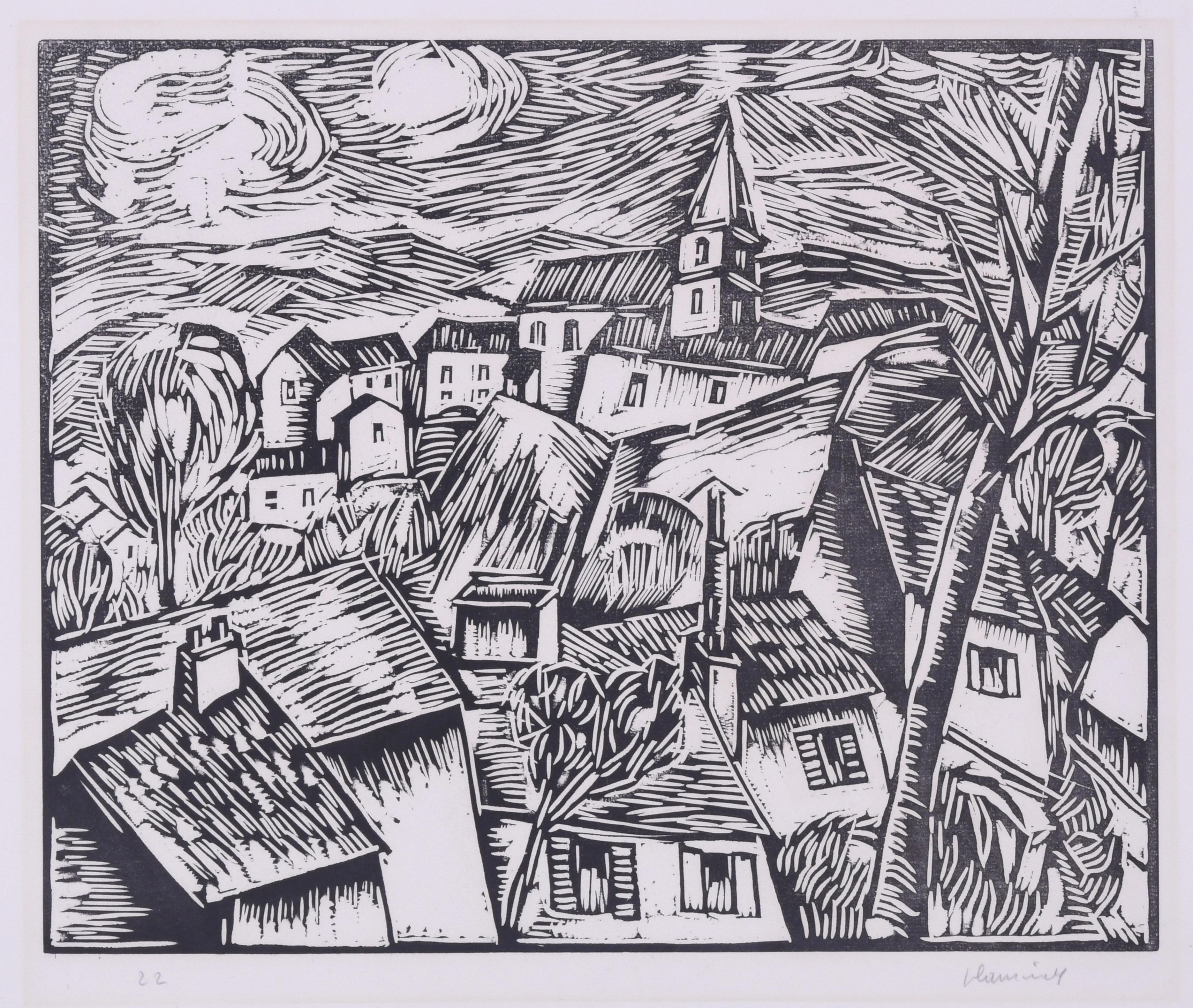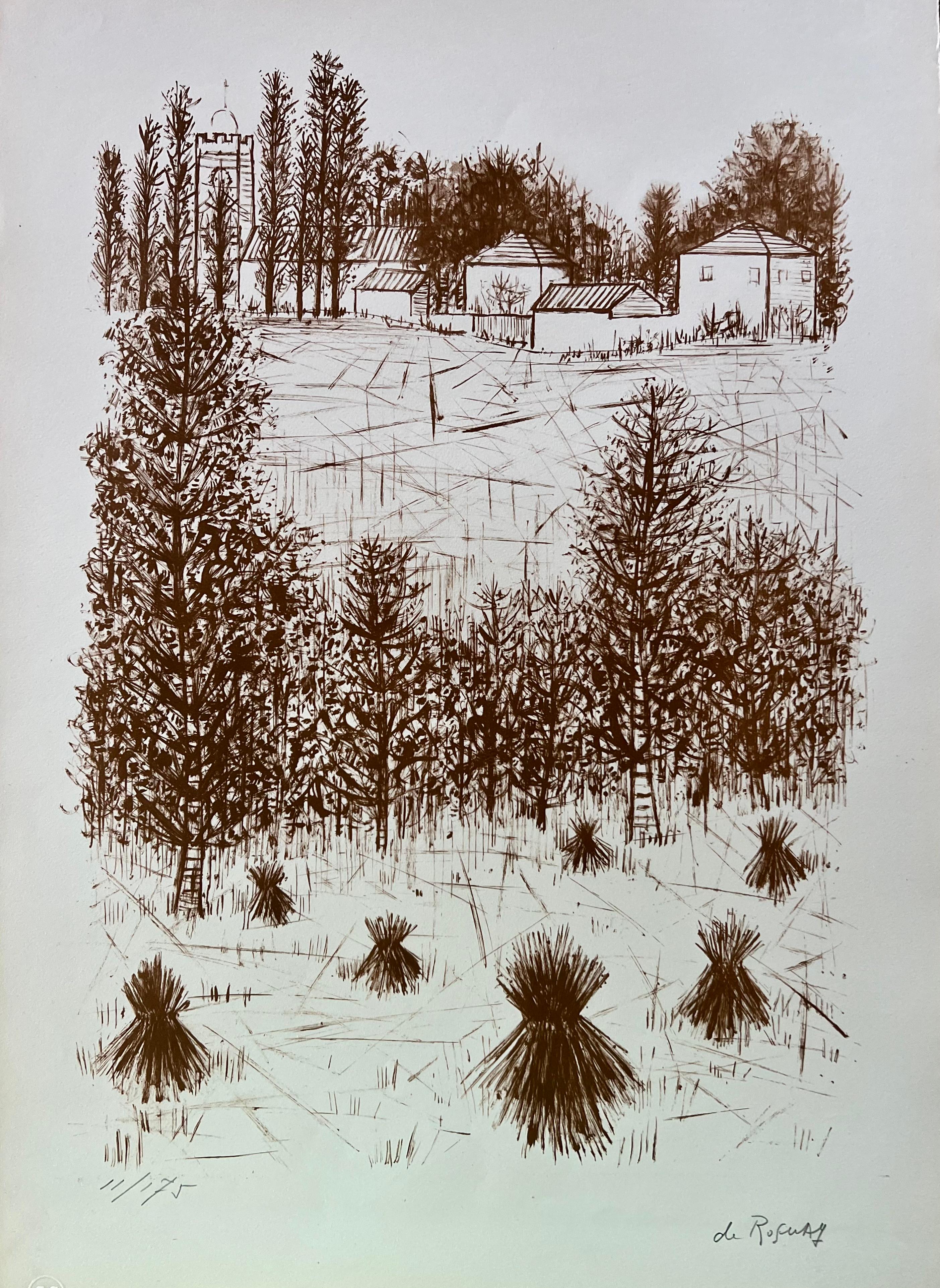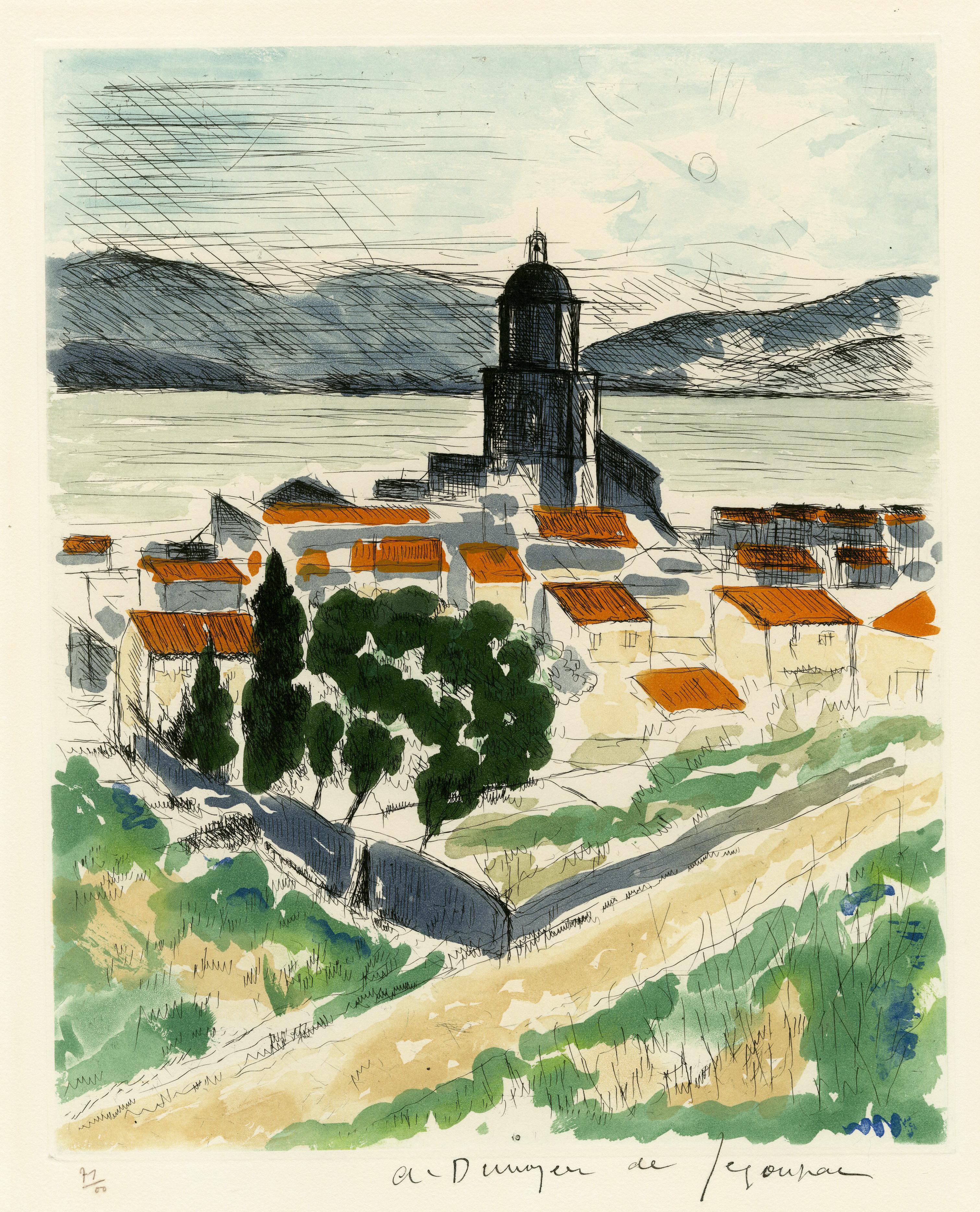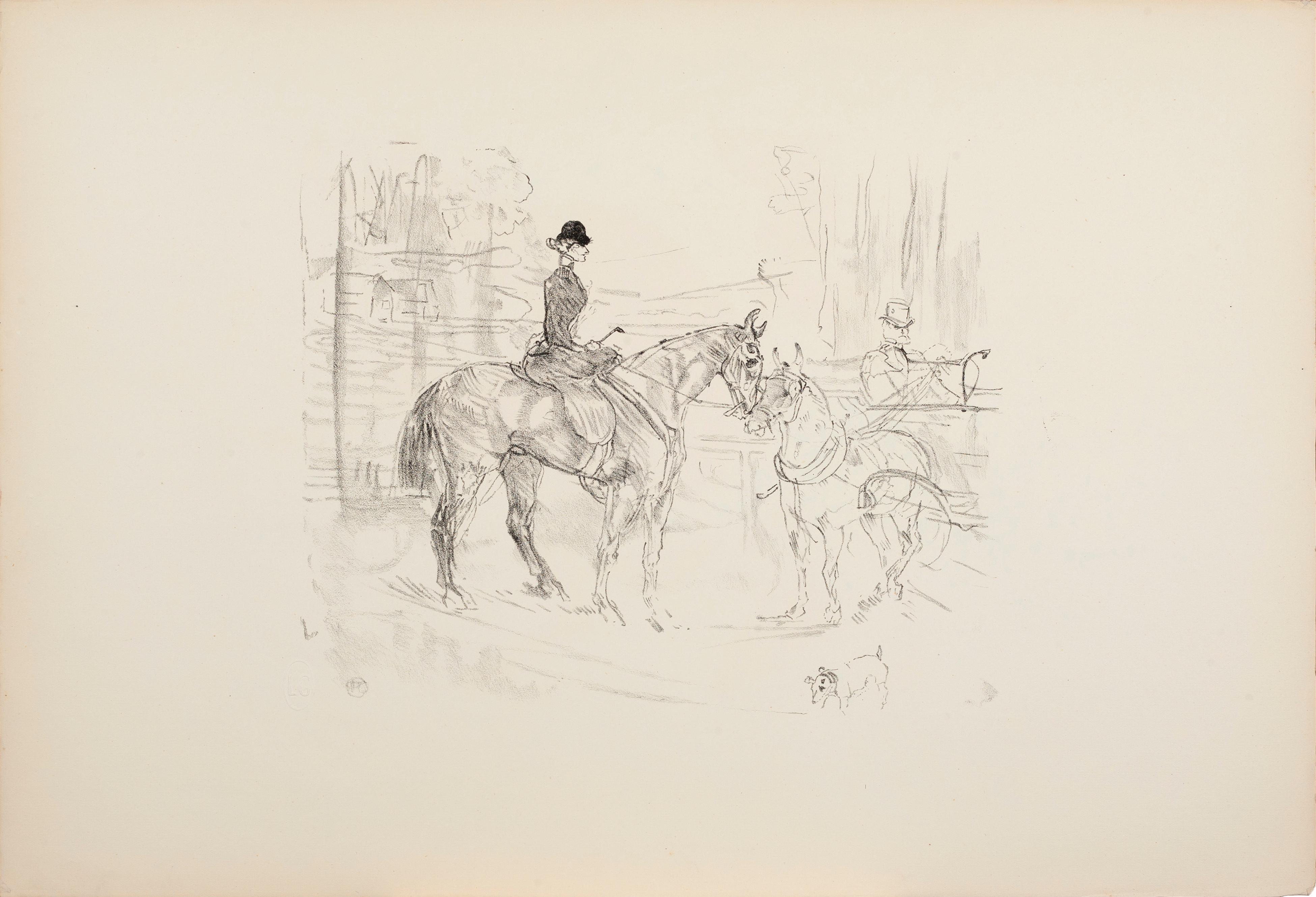Ludovic-Rodo PissarroQuincaillerie by Ludovic-Rodo Pissarro - Wood engravingcirca 1910
circa 1910
About the Item
- Creator:Ludovic-Rodo Pissarro (1878 - 1952, French)
- Creation Year:circa 1910
- Dimensions:Height: 4.1 in (10.4 cm)Width: 4.97 in (12.6 cm)
- Medium:
- Movement & Style:
- Period:
- Condition:
- Gallery Location:London, GB
- Reference Number:1stDibs: LU261213476242
Ludovic-Rodo Pissarro
Ludovic-Rodolphe Pissarro, born in Paris in 1878, was influential French Impressionist painter Camille Pissarro’s fourth son. Encouraged by his father, he began drawing from nature at an early age. He was familiarly known as “Rodo” and generally signed his works "Ludovic-Rodo,” or early on in his career, "Rodo.”
The impact of Camille’s art and teaching on Rodo was considerable, and his artistic production encompassed a wide range of media, including oil painting, tempera, watercolour, gouache, wood engraving, drawing and lithography. Rodo exhibited regularly at the Salon des Indépendents over a 40-year period.
In 1894, at the age of 16, Rodo published his first wood engravings in the anarchist journal, Le Père Peinard. When Camille left France for the safety of Belgium during the anarchist upheavals of the same year, Rodo joined him there.
Rodo moved into his first studio in Montmartre with his brother Georges in 1898. He found the nightlife of Paris and the habitués of the cafes, theatres, circuses and cabarets of the area compelling subjects for his work. With his younger brother, Paulémile, Rodo met artists such as Kees van Dongen, Maurice de Vlaminck and Raoul Dufy. In 1905, he participated in the first Fauve exhibition at the Salon des Indépendants.
At the outbreak of the War in 1914, Rodo moved to England. Over the next few years, he lived mainly in and around West London. He worked closely with his brother, Lucien, to establish, in 1915, the Monarro Group, formed with the aim of exhibiting work by contemporary artists inspired by Impressionism. Many of the works, produced by Rodo while he was in England, were of major London landmarks. After 1924, when Rodo had already returned to France, he divided his time between Paris and Les Andelys in Normandy. Despite his rich artistic heritage and his achievements as an artist, Rodo is perhaps best remembered for his contribution to art history. For 20 years, he researched and compiled a catalogue of his father’s paintings – a project that was finally published in two volumes in 1939 — and is still considered to be the definitive reference book on Camille’s work. Rodo told Lucien that the compilation of this catalogue was a fascinating task, revealing as it did “the work of the artist, its highs and lows, its progress, as a whole, through acquired experience.”
(Biography provided by Stern Pissarro Gallery)
- ShippingRetrieving quote...Ships From: London, United Kingdom
- Return PolicyA return for this item may be initiated within 7 days of delivery.
- Le Village de Landel by Paulémile Pissarro - etchingLocated in London, GBSOLD UNFRAMED Le Village de Landel by Paulémile Pissarro (1884 - 1972) Etching 17.2 x 23.7 cm (6 ¾ x 9 ⅜ inches) Signed lower right, Paulémile-Pissarro and numbered lower left, 2e e...Category
20th Century Post-Impressionist Landscape Prints
MaterialsEtching
- Series - Monet's House by Lélia Pissarro - ScreenprintBy Lelia PissarroLocated in London, GBSeries - Monet's House by Lélia Pissarro (B. 1963) Serigraph 38 x 48 cm (15 x 18 ⁷/₈ inches) Signed and numbered Printed in an edition of 300 Artist's Biography: Born in Paris in 19...Category
21st Century and Contemporary Post-Impressionist More Prints
MaterialsScreen
- Quai Boïeldieu, à Rouen by Camille Pissarro - Landscape lithographBy Camille PissarroLocated in London, GBQuai Boïeldieu, à Rouen by Camille Pissarro (1830-1903) Lithograph 27.7 x 36 cm (10 ⁷/₈ x 14 ¹/₈ inches) Stamped lower left and numbered lower right, 8/14 Executed circa 1896 Delteil...Category
1890s Post-Impressionist Landscape Prints
MaterialsLithograph
- Kerfany by Ludovic-Rodo Pissarro - Wood engravingBy Ludovic-Rodo PissarroLocated in London, GBKerfany by Ludovic-Rodo Pissarro (1878-1952) Wood engraving 10.9 x 13.9 cm (4 ¹/₄ x 5 ¹/₂ inches) Initialled and titled in the plate Signed lower right, Ludovic Rodo and numbered low...Category
20th Century Post-Impressionist Landscape Prints
MaterialsEngraving
- Le Café Georges à Cannes by H. Claude Pissarro - PastelBy Hughes Claude PissarroLocated in London, GB*UK BUYERS WILL PAY AN ADDITIONAL 20% VAT ON TOP OF THE ABOVE PRICE Le Café Georges à Cannes by H. Claude Pissarro (b. 1935) Pastel on card 37 x 51 cm (14 ⁵/₈ x 20 ¹/₈ inches) Signe...Category
21st Century and Contemporary Post-Impressionist Landscape Prints
MaterialsPastel
- Paysage à Asquins by Paulémile Pissarro - Wood Engraving PrintLocated in London, GB*UK BUYERS WILL PAY AN ADDITIONAL 20% VAT ON TOP OF THE ABOVE PRICE SOLD UNFRAMED Paysage à Asquins by Paulémile Pissarro (1884 - 1972) Wood engraving 9.7 x 15.5 cm (3 ⁷/₈ x 6 ¹/₈...Category
20th Century Landscape Prints
MaterialsEngraving, Wood
- BougivalBy Maurice de VlaminckLocated in Fairlawn, OHBougival Woodcut, 1914 Signed and numbered in pencil Edition 30, this numberd 22 Printed on laid Van Gelder Zonen paper Published by Henri Kanweiler, Paris Printed by Paul Birault, Paris Bougival is located west of Paris, on the left bank of the River Seine. This woodcut was inspired by Vlaminck's 1905 Fauvist masterpiece of the same title in the collection of the Detroit Institute of Art. An impression of this image is in the Yale Univeristy Art Gallery, Condition: Very slight sun staining, otherrwise very good Image/block size: 13 1/4 x 16 1/4 inches Sheet size: 19 1/8 x 22 1/8 inches Reference: Walterskirchen 11b Maurice de Vlaminck (4 April 1876 – 11 October 1958) was a French painter. Along with André Derain and Henri Matisse, he is considered one of the principal figures in the Fauve movement, a group of modern artists who from 1904 to 1908 were united in their use of intense colour.] Vlaminck was one of the Fauves at the controversial Salon d'Automne exhibition of 1905. Life Maurice de Vlaminck was born on Rue Pierre Lescot in Paris. His father Edmond Julien was Flemish and taught violin and his mother Joséphine Caroline Grillet came from Lorraine and taught piano His father taught him to play the violin.[3] He began painting in his late teens. In 1893, he studied with a painter named Henri Rigalon on the Île de Chatou In 1894 he married Suzanne Berly. The turning point in his life was a chance meeting on the train to Paris towards the end of his stint in the army. Vlaminck, then 23 and already active in anarchist circles in Paris, met an aspiring artist, André Derain, with whom he struck up a lifelong friendship.] When Vlaminck completed his army service in 1900, the two rented a studio together, the Maison Levanneur, which now houses the Cneai,[6] for a year before Derain left to do his own military service. In 1902 and 1903 he wrote several mildly pornographic novels illustrated by Derain. He painted during the day and earned his livelihood by giving violin lessons and performing with musical bands at night. Vlaminck participated in the controversial 1905 Salon d'Automne exhibition. After viewing the boldly colored canvases of Vlaminck, Henri Matisse, André Derain, Albert Marquet, Kees van Dongen, Charles Camoin, and Jean Puy, the art critic Louis Vauxcelles disparaged the painters as "fauves" (wild beasts), thus giving their movement the name by which it became known, Fauvism. In 1911, Vlaminck traveled to London and painted by the Thames. In 1913, he painted again with Derain in Marseille and Martigues. In World War I he was stationed in Paris, and began writing poetry. Eventually he settled in Rueil-la-Gadelière, a small village south-west of Paris. He married his second wife, Berthe Combes, with whom he had two daughters. From 1925 he traveled throughout France, but continued to paint primarily along the Seine, near Paris. Resentful that Fauvism had been overtaken by Cubism as an art movement Vlaminck blamed Picasso "for dragging French painting into a wretched dead end and state of confusion". During the Second World War, Vlaminck visited Germany and on his return published a tirade against Picasso and Cubism in the periodical Comoedia in June 1942. Vlaminck wrote many autobiographies. Vlaminck died in Rueil-la-Gadelière on 11 October 1958. Artistic career Two of Vlaminck's groundbreaking paintings, Sur le zinc (At the Bar) and L'homme a la pipe (Man Smoking a Pipe) were painted in 1900. For the next few years Vlaminck lived in or near Chatou (the inspiration for his painting houses at Chatou), painting and exhibiting alongside Derain, Matisse, and other Fauvist painters. At this time his exuberant paint application and vibrant use of colour displayed the influence of Vincent van Gogh. Sur le zinc called to mind the work of Toulouse-Lautrec and his portrayals of prostitutes and solitary drinkers, but does not attempt to probe the sitter's psychology—a break with the century-old European tradition of individualized portraiture. According to art critic Souren Melikian, it is "the impersonal cartoon of a type. In his landscape paintings, his approach was similar. He ignored the details, with the landscape becoming a vehicle through which he could express mood through violent colour and brushwork. An example is Sous bois, painted in 1904. The following year, he began to experiment with "deconstruction," turning the physical world into dabs and streaks of colour that convey a sense of motion. His paintings Le Pont de Chatou (The Chatou Bridge), Les Ramasseurs de pommes de terre (The Potato Pickers...Category
1910s Fauvist Landscape Prints
MaterialsWoodcut
- MaruruBy Paul GauguinLocated in San Francisco, CAOriginal woodcut printed in black ink on chine volant paper Titled and signed in the block with the artist’s monogram lower right MARURU PGO. A superb impression of the definitive...Category
1890s Post-Impressionist Landscape Prints
MaterialsWoodcut
- untitled, farm scene with wheat bundlesLocated in Belgrade, MTThis lithograph is part of my private collection from the 20th Century School of Paris. It is original, pencil signed and numbered by the artist. Guilde de la Gravure. It is in very...Category
Mid-20th Century Post-Impressionist Landscape Prints
MaterialsLithograph, Paint
- Saint TropezBy André Dunoyer de SegonzacLocated in Fairlawn, OHSaint Tropez Etching with aquatint, printed in colors, 1964 Signed in ink and numbered in pencil Edition: 71/100 Issued for the album St. Tropez et la Provence, in 1966 Reference: Lo...Category
1960s Post-Impressionist Landscape Prints
MaterialsEtching
- Arch of the Pont Neuf, ParisBy Sir Frank BrangwynLocated in Fairlawn, OHArch of the Pont Neuf, Paris Etching on heavy wove paper, 1923 Signed in pencil lower right (see photo) From: Brangwyn Portfolio (12 original etchings and thr...Category
1920s Post-Impressionist Landscape Prints
MaterialsEtching
- Amazone et TonneauLocated in Columbia, MOHENRI DE TOULOUSE-LAUTREC Amazone et Tonneau 1948 Lithograph on paper Ed. 166/740 20.5 x 14 inchesCategory
19th Century Post-Impressionist Figurative Prints
MaterialsLithograph






